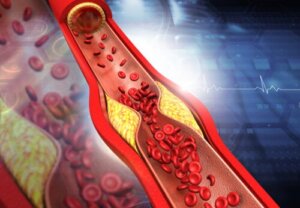Symptoms and Tips for Raising HDL Cholesterol Levels

Cholesterol is a type of fat that is indispensable in order for your body to function correctly. The best known forms are HDL or good cholesterol and LDL or bad cholesterol. Here’s everything you need to know to raise HDL levels.
The human body uses cholesterol as a source for the production of various hormones, vitamins and substances involved in digestion. It’s transported in the blood by a group of proteins known as lipoproteins. High-density lipoprotein (HDL) is responsible for collecting cholesterol in the blood and returning it to the liver for elimination.
In general, low levels of HDL cholesterol and high levels of LDL cholesterol are considered an important cardiovascular risk factor for atherosclerosis, according to studies. In this regard, it’s essential to ensure a proper balance of these fats in the blood.
Functions of HDL cholesterol in the human body
HDL are a group of lipoproteins responsible for removing fatty substances or excess lipids found in the blood vessels. In this sense, they act as a chemical transport medium that prevents the accumulation of fat in the circulation and peripheral tissues.
Once loaded with lipids, HDL will travel to the liver, where they’ll deposit the excess cholesterol. Liver enzymes will then metabolize it and use it to form new substances. Research affirms that the cholesterol acquired by the liver from HDL is preferentially used to produce bile.
On the other hand, these high-density lipoproteins have anti-inflammatory, anticoagulant, antithrombotic, and antioxidant properties. They’re also actively involved in the production and release of steroid hormones, such as testosterone and estrogens, as well as in vitamin D synthesis and calcium metabolism.
HDL cholesterol is considered a protective factor against several diseases, such as myocardial infarction, angina pectoris, and strokes. Some studies claim that people with low HDL levels are up to 8 times more likely to suffer from cardiovascular pathology.

You may be interested in reading: 6 Tips to Help You Prevent a Stroke
How do you know if HDL cholesterol is low?
In general, blood tests can determine the levels of total circulating cholesterol. This test is called lipid profile and is useful in the assessment of HDL, LDL, VLDL and triglyceride levels.
It’s recommended to perform this test every 5 years in young adults and every 1 to 2 years in men over 45 years and in women over 55 years. The results are usually expressed in milligrams of cholesterol per deciliter (mg/dl). In the case of HDL cholesterol, higher concentrations are usually more beneficial.
The desirable HDL value in men and women is 60 mg/dL or higher. On the other hand, concentrations below 40 mg/dL in men or 50 mg/dL in women constitute a risk factor.
Studies of international protocols state that HDL cholesterol levels below 40 mg/dL greatly increase the likelihood of developing coronary heart disease. Furthermore, low HDL levels are estimated to be the most common dyslipidemia in Europe.
Associated symptoms
In most cases, low HDL cholesterol doesn’t produce any obvious symptoms. However, blood lipid imbalance sustained over time can generate several long-term manifestations.
Some of the symptoms and signs most associated with this condition are as follows:
- Swelling of the hands and feet
- Gas and abdominal discomfort
- Overweight or obesity
- Unexplained fatigue
- Headaches
- Blurred vision
- Palpitations
- Sweating
- Dry mouth
In severe cases, some people may experience severe chest pain as a symptom of a heart attack, or even a loss of consciousness. In the presence of these manifestations, professional help should be sought immediately.
Causes of low HDL
There are a variety of factors that can cause low HDL cholesterol. Most are associated with the lifestyle and habits of each person, among which we find the following as detrimental:
- Obesity
- Sedentary lifestyle
- Smoking
- Chronic alcohol consumption
- Food rich in trans fats, sugars and processed foods
Similarly, metabolic syndrome and diabetes mellitus are frequent causes of low HDL and high LDL. Excessive use of corticosteroids is also associated with redistribution of body fat, accompanied by cholesterol and triglyceride imbalance.
There are genetic and hereditary factors that predispose certain groups of people.
Tips to raise HDL cholesterol levels
Most of the causes of this dyslipidemia are related to lifestyle. For this reason, it’s possible to increase HDL cholesterol levels in the blood with some changes to our diet and habits.
Read also: Is VLDL Cholesterol Harmful?
1. Healthy and balanced diet
Diet is one more part of controlling cholesterol levels. Some foods can raise HDL, while others lower it.
It’s advisable to consume good fats, monounsaturated and polyunsaturated, to replenish HDL reserves in the body. To this end, it’s advisable to increase the intake of the following products:
- Oily fish, such as salmon, sardines, tuna, horse mackerel and mackerel.
- Nuts, such as almonds, walnuts, hazelnuts and peanuts.
- Vegetables, such as avocado and olives.
- Seeds, such as chia, sunflower, pumpkin and flaxseed.
- Olive oil.
Saturated fats and trans fats greatly alter the concentration of HDL in the blood. We should therefore reduce or eliminate the consumption of the following foods:
- Fried foods
- Sausages and processed products
- Sugary soft drinks
- Margarine and coconut oil
- Non-fat dairy products
2. Keep weight under control
Obesity and the presence of fat around the waist are related to higher LDL levels. In this sense, losing weight and keeping it close to ideal is fundamental in order to raise HDL cholesterol and avoid the appearance of multiple diseases related to this condition.
3. Exercise
Regular physical activity is a great option to raise good cholesterol. Physical exercise combined with a balanced diet are the ideal formula to achieve this goal.
To do so, professionals recommend practicing 30 to 40 minutes of light to moderate aerobic exercise 3-4 times a week. Such is the case of walking, running or cycling.
4. Stop smoking
Regular consumption of cigarettes or tobacco reduces HDL cholesterol and increases the concentration of LDL and triglycerides. Especially in women.
In addition, passive exposure also achieves this effect. For this reason, it’s advisable to quit the habit, giving it up gradually.
5. Reduce alcohol intake
It’s known that moderate alcohol consumption may be beneficial in increasing HDL. This consumption pattern corresponds to 2 glasses of wine per day in men under 65 years of age and 1 glass per day in men over 65 years of age or women of all ages.
However, long-term sustained and excessive alcohol consumption promotes liver dysfunction and fat retention. Therefore, it’s advisable to maintain a moderate intake.

Effects of drugs on HDL cholesterol levels
Currently, there are drugs used in the medical control of HDL concentrations. The main alternatives are niacin and fibrates, such as ciprofibrate and gemfibrozil.
These can raise HDL cholesterol concentrations by up to 30%. In addition, some statins, such as simvastatin and rosuvastatin, are also used. However, these drugs don’t reduce the risk of heart attacks in people with chronic dyslipidemias.
On the other hand, it should be known that certain drugs are capable of reducing good cholesterol levels as an adverse effect:
- Beta-blockers
- Anabolic steroids
- Progestins in contraceptives
- Benzodiazepines
A key factor in the prevention of cardiovascular diseases
HDL cholesterol is a form of cholesterol that facilitates the elimination of excess fat in the blood. In this way, it’s able to prevent the formation of atherosclerotic plaques in the blood vessels. Consequently, it reduces the incidence of cardiovascular disease.
A decrease in HDL levels can go unnoticed for several years, so regular blood tests are essential. Fortunately, changes in diet and lifestyle habits go a long way toward maintaining balance.
All cited sources were thoroughly reviewed by our team to ensure their quality, reliability, currency, and validity. The bibliography of this article was considered reliable and of academic or scientific accuracy.
- Ferrer Civeira M, Salor Moral D, Recarte García-Andrade C, Millán Núñez-Cortés J. Colesterol HDL bajo: un factor lipídico asociado a índice tobillo brazo (ITB) patológico. Clínica e Investigación en Arteriosclerosis. 2011;23(4):155-159.
- Attilio R. Actualización en el manejo del colesterol hdl bajo. Revista Médica Clínica Las Condes. 2012;23(6):689-692.
- Aguilar C, Melgarejo M. Análisis de la composición y de la función de las HDL, ¿un estudio para el clínico del futuro?. Revista de Endocrinología y Nutrición. 2011; 19 (3): 113-122.
- Schade DS, Shey L, Eaton RP. Cholesterol Review: A Metabolically Important Molecule. Endocr Pract. 2020 Dec;26(12):1514-1523.
- Cortes VA, Busso D, Maiz A, Arteaga A, Nervi F, Rigotti A. Physiological and pathological implications of cholesterol. Front Biosci (Landmark Ed). 2014 Jan 1;19(3):416-28.
- Alvirde-García U. Dislipidemias e hipertensión arterial [Dyslipidemia and hypertension]. Gac Med Mex. 2016 Sep;152 Suppl 1:56-62.
This text is provided for informational purposes only and does not replace consultation with a professional. If in doubt, consult your specialist.








